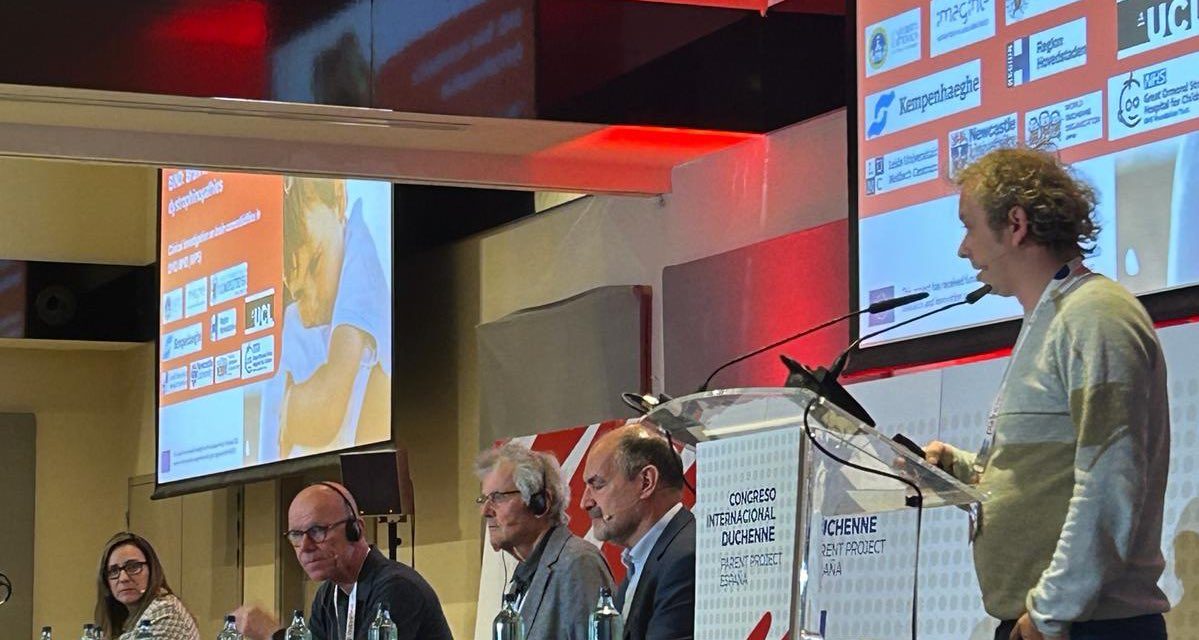On May 11, 2024, during the Annual Conference of Duchenne Parent Project Spain, representatives from the BIND consortium participated in a session titled “Cognitive Part in DMD/BMD: Project BIND.” The participants presented the general lines of clinical research aimed at identifying cognitive, behavioral, and neuropsychiatric comorbidities in DMD/BMD patients.
First, Dr. Rubén Miranda (Universidad Complutense de Madrid, Spain) introduced the clinical teams involved in this large-scale European study and presented the main phases and objectives of the project:
- Identification of the main behavioral areas affected in DMD/BMD (Part 1 – online questionnaires).
- Estimation of the incidence of neuropsychiatric comorbidities (Part 1 – DAWBA).
- Deep cognitive phenotyping (Part 2 – neuropsychological assessment).
- Development of a short screening tool for assessing red flags in the neurocognitive and neuropsychiatric domains (Part 3)
Dr. Rubén Miranda continued by discussing the project’s main challenges and ambitions, such as identifying risk factors like the mutation location, developing a protocol for assessing brain comorbidities in DMD/BMD, and transferring relevant information and tools to the clinical and patient community. He then explained the fundamental causes for the presence of brain comorbidities in DMD/BMD, highlighting the expression of multiple forms of dystrophin (Dp427, Dp140 and Dp71) in the brain. The loss or reduced expression of these isoforms can have a variable impact on the DMD/BMD brain structure and function. Preclinical teams from the BIND consortium are further working to better understand the temporal and spatial expression of these different forms of brain dystrophin. Each form of brain dystrophin appear to be involved in different processes. Dp427 is known to play an important role in inhibitory transmission through the stabilization of GABA receptors, Dp71 has been associated to excitatory transmission (glutamatergic) and ionic homeostasis, and Dp140, mainly expressed during early developmental stages, is thought to play a role in neurodevelopment processes.
After this introduction, Dr. Rubén Miranda presented preliminary data and results from the project. Focusing on the Spanish sample, he discussed the percentages of patients at risk for psychosocial adjustment problems and diagnosed with a neuropsychiatric disorder (e.g., language disorder, intellectual disability, ASD, ADHD, Anxiety, etc.). In the cognitive and academic domains, he reported the proportion of patients performing below average in short-term memory, reading, and math skills, as well as with low IQ levels.
Next, Dr. Jos Hendriksen (Kempenhaeghe and Maastricht University’s School of Mental Health and Neuroscience, Netherlands) took the floor to present his ‘Big Ten’ model in Duchenne, which encompasses the ten most common and frequent areas of cognition and behavior affected in DMD patients, organized into four domains:
- Cognition (Intelligence, Working Memory, and Executive Functions).
- Academic Performance (Learning) (Dyslexia and Dyscalculia).
- Emotion (Anxiety and Depression).
- Behavior (ADHD, ASD, OCD).
In DMD, it is rare to observe impairment in only one of these areas or domains. Generally, patients show a combined manifestation with varying degrees of impairment across these areas and domains. Difficulties in these domains can impact patients’ daily lives and cause problems in school. Teachers, who are not always aware that muscular pathology can be accompanied by neurocognitive and behavioral problems, may misinterpret the abilities of affected children. For example, difficulties in quickly switching their attention and continuing with another task are often misinterpreted as a lack of motivation. The issue is that children may be unable rather than unwilling.
Dr. Jos Hendriksen then focused on the treatment situation and needs for these brain comorbidities in DMD/BMD, emphasizing the prescription and effectiveness of psychopharmacological therapy. Through the review of published studies he could suggest that such treatments are effective and safe. Dr. Jos Hendriksen continued by presenting a new screening tool (BIND screener) developed to detect ‘red flags’ and diagnoses associated with brain comorbidities in DMD/BMD and to collect data on assessments, treatments received, and unmet concerns or needs of patients/families. This tool can detect problems in 9 areas of interest through responses to 18 items on anxiety, depression, reading, arithmetics, ADHD, OCD, memory, executive functions, and ASD. The tool, available in 7 different languages and already distributed in many countries with the help of the World Duchenne Organization (WDO), has proven effective and reliable in detecting patients at risk for these brain comorbidities that form part of the ’Big Ten’.
Dr. Rubén Miranda then showed preliminary results from a sample of over 600 patients/families that responded to the BIND screener, confirming that a significant proportion of patients are undertreated for the brain comorbidities. Remarkably, psychopharmacological therapy is being administered to a very low percentage of diagnosed patients, while families acknowledge that these problems are a burden and wish to receive more support. Dr. Rubén Miranda concluded by presenting future directions and commitments from BIND consortium, focusing on incorporating diagnostic or screening tools like the BIND screener and new neuropsychological assessment and treatment recommendations into care standards.
Following the presentation, Dr. Marisol Montolio (Director of the Research and Technology Departments of Duchenne Parent Project Spain) moderated a Q&A session. Dr. Rubén Miranda, Dr. Jos Hendriksen, Dr. David Skuse (UCL Great Ormond Street Institute of Child Health in London, UK.) and Dr. Eugenio Mercuri (Catholic University of the Sacred Heart and Nemo Clinical Center Foundation IRCCS Twin Polyclinic in Rome, Italy) joined this roundtable. Dr. Marisol Montolio posed several questions representing common concerns among the patient/family community.
Dr. Jos Hendriksen responded to whether DMD is progressive at the cognitive level, stating that while cognitive deficits in DMD are generally non-progressive, developmental aspects such as the transition to adolescence can be associated with new problems and/or modulate their manifestation and impact on daily life. Additionally, progressive self-awareness of physical limitations can influence affective or emotional changes.
Dr. Rubén Miranda addressed the question about genotype/phenotype correlation, noting that this is one of the main study objectives in BIND. Previous data suggest that the risk and severity of cognitive problems increase with distal mutations that affect the expression of different brain dystrophin isoforms. Preliminary BIND data align with this, confirming that general intelligence and specific cognitive areas like memory, attention, and executive functions are more affected when mutations impact the expression of short dystrophin isoforms. Regarding neuropsychiatric comorbidities, available data are not yet definitive, and BIND will conduct further analyses to clarify the potential genotype/phenotype correlation for these comorbidities.
Dr. Eugenio Mercuri answered the question about the relationship between motor function and cognitive problems. While cognitive deficits are generally non-progressive compared to muscular pathology and motor problems, recent studies reveal that aspects of motor development can be differently altered depending on the mutation location. For example, the risk of delayed sitting or walking is higher in patients with mutations affecting the expression of short dystrophin forms (Dp140 and Dp71). These results mirror what is observed in the neurocognitive domain, suggesting a possible parallel between cognitive problems and the motor phenotype.
Finally, Dr. David Skuse addressed whether BIND data could help develop new drugs or treatments with brain effects. Clinically, BIND results are expected to identify the main neurocognitive and neuropsychiatric comorbidities in DMD. This would help delineate the most relevant aspects for future therapy development or suggest the application of known therapies like psychopharmacological treatments in DMD. Preclinically, BIND is evaluating the therapeutic potential of different gene therapy compounds acting on the nervous system. Future results are expected to determine which aspects of behavior and cognition could be restored postnatally by the therapy.
The session ended with an open Q&A for attendees. Families shared their experiences and asked experts about their concerns regarding neurocognitive and/or neuropsychological assessments, treatment and/or neuropsychological rehabilitation options, school difficulties, behavioral challenges associated with adolescence, the importance of precise mutation localization, and the current status of gene therapy clinical trials and their potential effects on the nervous system.
This summary is provided by Dr. Rubén Miranda and Dr. Jos Hendriksen (on behalf of the BIND clinical teams)







